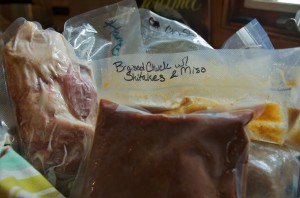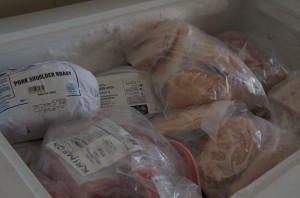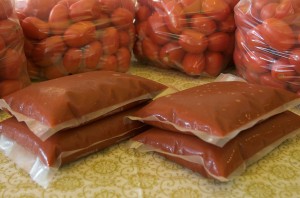My Frozen Treasure Chest
Posted by admin | January 27, 2010 | Filed under: Organization
Colleen, this one’s for you–albeit probably a little late.
The farmer’s market is a community for me not unlike church or a PTA–or for my mom, the sales staff at Nordstrom’s. I love Monday mornings during the season not just because finding heirloom potatoes is as thrilling as finding Jimmy Choo shoes on discount but also because I get a chance to connect with people I like there and talk about stuff I love. It is a delight for me on every level.
Late last summer, I ran into one of my former students. She was aglow and, well, rather rounder than she was when I last saw her. It wasn’t that she became overly enthusiastic about cooking since my last class. Rather, she was expecting her second child. We caught up on the miscellanea of our lives. She then told me that she wanted to prepare and freeze meals ahead of time so that she knew she’d be able to eat well after the baby came. I offered her a few tips at that moment.
As I walked away, I realized how very much I depend on my freezer stash to get me through life. Making extras of whatever I cooked was how I first was able to jump from just one home-cooked meal a week to two- the second meal was just something I’d made previously and frozen. When I plan my meals for the week, I know that on Wednesday and Thursday nights the kids’ schedule just doesn’t allow me any time to put together anything from scratch, so I pull something out of the freezer. Heck, there’s a whole industry that has cropped up around the idea of assembling a meal that someone else prepped and freezing it. I promise you’ll save a lot of money and be more psyched about what’s for dinner if you’re freezing your own recipes or ones that sound exciting to you.
A freezer stash is a collection of food that has already been prepared and can either just be a) thawed and reheated or b) thawed and turned into yet another dish. In the former category, we have things like Bolognese Sauce, Chicken Curry and Creamy Asaparagus Soup. In the latter category, we have things like chicken pickins (leftover pieces of chicken pulled off a roasted chicken), Strawberry Rhubarb Sauce and turkey gravy.
The freezer stash is fundamental to home cooking because:
- It offers a home-cooked option on days when there’s no time or inclination to cook
- It saves a good amount of money as you learn to repurpose leftovers
- You get the benefit of multiple meals for the same cooking and clean-up time
- It offers a great way to savor the best of seasonal produce year round.
What Happens to Food When We Freeze it?
Because bacteria need a liquid environment to grow, freezing food effectively suspends their life processes by turning all liquids in food into crystals. The drawback is that crystals are pointy, and puncture the cells in meat and produce. When the food thaws, the punctured cells leak a lot of liquid from their punctured cell walls, leaving the frozen food soggier and sitting in a puddle of their own goodness. As I am sure you can detect when you freeze produce, the texture of the food is inevitably softer than it was when it was fresh.
Flash freezing is freezing food quickly at super low temperatures. The texture of the flash frozen fish I buy is virtually unaltered because it is flash frozen. Why? The faster you freeze something, the smaller the ice crystals are. The smaller they are, the less they damage the cells of the food.
Freezer burn occurs from a process called sublimation, which is entirely too complicated to want to understand but is the equivalent of evaporation in a frozen environment. The crystals on the surface of the food leach into the surrounding air over time, effectively freeze drying the exposed food. If you eliminate airspace around the food, you eliminate the possibility of freezer burn.
Essential Equipment
The Freezer
You may just be thinking what a fantastic idea this is. “Why, I’ll get started tomorrow!” But wait! If you haven’t worked on the issue of freezer space, it’ll be like trying to raise quadruplets in a Manhattan studio apartment. There are a few ways to deal with this issue:
- Eat your way through your stock of frozen prepared foods that are already crowding your fridge. Replace them with the home-cooked meals you’re making.
- Freeze things one week, eat them in the next two. You can’t build a huge stash, but you can probably fit three to five meals in there, depending on how big your family is.
- Buy a chest freezer. Unless space is at an absolute premium, consider this option. You can get a small chest freezer for around $200. They use very little electricity because they are well-insulated and are opened so infrequently. You can put it in the garage or basement. Ours is in our detached unheated garage. People are always wondering if the extremes of temperature affect it but we’ve never had any kind of problem. Another upside of this option is that it allows you to buy quality meats in bulk as well as freeze and store seasonal produce. I’ll talk more about this kind of bliss in a forthcoming article.
Air+Time=Freezer burn
I know people who have been successful freezing food in zip-top freezer bags. They use a straw to draw most of the residual air out of the bag and seal it shut. The upsides of the zip top bag are that they’re relatively cheap and widely available. The downsides are that they’re thin, so they can easily develop small tears from being banged around in the freezer with all the frozen food, allowing leakage when thawed. In fact, their zip tops can also be a source of leakage as well. Their material doesn’t stand up to very hot water for thawing. Finally, you just can’t get a true vacuum by sucking out the air. You also probably don’t want to orally suck the air out of raw meatloaf mix.
I’m sold on vacuum sealers. They allow me to get a total vacuum seal, the bags are tough and they stand up well to heat and tearing. I can custom cut the bags to just the right size. Finally, the appliance seals up any other plastic bags for snacks or ingredients: preventing spoilage and proving surprisingly effective against that sort of “handful” snacking. Detractors point out that the appliance takes up counter space and that the bags are a little pricey. As for the pricey argument, the time and money I invest in preparing the food that I store in these bags are worth preserving well.
I’m on my third FoodSaver. I burned out the first two. I’d purchased both of the previous models at Costco so I purchased a third there- it was the upright model they now have. Piece of crap. Returned it. Turns out, I hear, that the models that Costco carries are manufactured specifically for them so they can carry them at a lower price. I bought a “commercial” model FoodSaver and it’s the best one I’ve had yet.
Finally, please don’t be penny wise and pound foolish by trying to reuse either kind of plastic bag. For all your efforts you’ll probably save yourself $20 a year, which will be easily wiped out by the personal and medical costs of foodborne illness. You can’t get them adequately clean because of their seams and ridges. Don’t believe me? Okay, time to do a science experiment with the kids. Pick up some petri dishes and agar at your local hobby store and swab the inside corners of a clean bag and a well-washed and dried reused bag. See what grows. Hey, good idea for the science fair next year, eh?
What to Stash
Some foods freeze better than others. The simple rule is that anything that has a liquid base freezes very well- in fact the flavors tend to improve over time. This includes soups, stews, braises, stock, sauces and simmered dishes.
Baked goods can freeze well too- the best being a uniform loaf of some sort around which you can get a uniform seal. Actually, if I’m trying to freeze an extra loaf of pumpkin bread, I’ll first freeze it until solid in the freezer wrapped in plastic wrap or aluminum foil. I’ll then vacuum seal it. Why? I don’t want the vacuum process to draw the moisture out of the bread or crush the loaf. If you’re trying to freeze a bag of muffins or leftovers, you’ll probably want to consume them within two weeks or they’ll develop a funky freezery taste and texture. Again, that’s the air problem.
Everything else needs a little more thought.
- Casseroles: Make the saucy part of the mix and freeze it. This is usually the most time-consuming part of the dish anyway. On the day you’re going to eat it, mix or layer it with the rice or noodle, layer on the cheese and bake it.
- Roasted, grilled or sautéed pieces of meat: Getting rid of air is very important. When served again, the dish will lack the texture and flavor it originally had because of the effect of the process of freezing. The best use is to either sauce it to distract from this quality or re-purpose it. For ex: I will roast a turkey when they’re on sale after Thanksgiving and then cut it into parts and freeze them individually. I’ll then turn them into soup or pot pie or a curry or sandwiches. Get it?
- Vegetables: If they’re not in a liquid base and they’re already cooked, they’d have to be re-purposed or pureed. They’ll be mush after they’re thawed.
There are a few things I’d never dream of trying to successfully freeze. Anything that has a breading on it will be pretty gross when its defrosted. The breading will absorb the moisture that leaches from the meat and will turn to slime. Don’t ask how the makers of frozen chicken nuggets get away with it. You really don’t want to know. Pastas and other noodle dishes are a no-no too. There are just too many spaces created by the way the noodles fall together in the bag that create texture problems over time. And if you really suck the air out, you crush your noodles. I’d never freeze a stir-fried dish. The veggies will be flat and limp when reheated. If its on my plate, I want my veggies to have some structure and bite. Finally, I generally feel that seafood doesn’t reheat very well. Eating reheated fish is like watching a 50-year old woman on her second marriage march down the aisle in a virginal, pearl-festooned gown and veil. You really only get one shot at seafood. Err on the side of conservatism when considering the portion of fish to cook.
A few other tips that will save you some grief.
- Soups: DO NOT add noodles rice or other grains to the soup before freezing. They’ll fall apart in the liquid. Frankly, the same rule applies to fridge storage as well. I make and store the noodles separately from the soup when I make chicken noodle soup. I just put some noodles in the serving bowls and ladle the soup over them. One cool thing about doing it this way is that when you next use that chicken soup, you can use wild rice or spaetzle or orzo or whatever you fancy that day.
- Stews and braises: Remove the meat before reheating the liquid. Get the liquid warmed up, add the meat back in and turn the heat off or down to the lowest simmer possible to just get that meat warmed through. Nothing’s more annoying than overcooking the meat and having it fall apart in the pan, unless, of course you have no teeth and have to be on a soft diet anyway.
- Label everything: Strawberry applesauce looks a lot like marinara when frozen. ‘Nuff said.
- Keep prepared foods together in the fridge, if possible. It makes it easy to identify one of these ready meals in a pinch. I keep mine together in a giant zip-top bag.
- How long will it last? If the air is totally out, indefinitely. With air in it, two weeks for baked goods and two months for everything else. The presence of ice crystals will tell a lot of the story about how well preserved it is.






